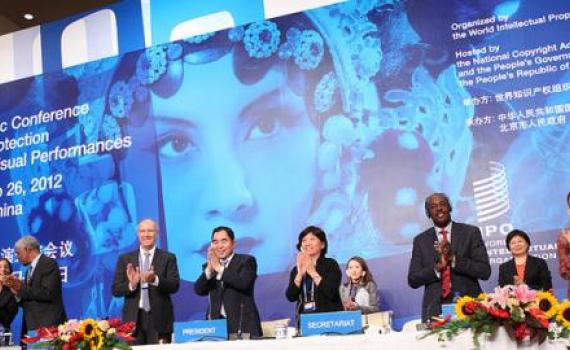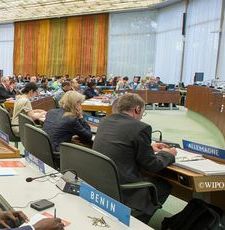
The Beijing Treaty on Audiovisual Performances an EIFL Briefing for Libraries
The Beijing Treaty and libraries - an EIFL webinar (September 2013)
Slides and recording available
On June 24, 2012, member states of the World Intellectual Property Organization (WIPO) adopted the Beijing Treaty on Audiovisual Performances (TAVP) at a diplomatic conference. The aim of the treaty is to provide legal protection to performers in audiovisual works, such as actors in motion pictures. Although the practical impact of the TAVP on most libraries is likely to be slight, it is important for librarians to have a general understanding of the first international copyright treaty adopted in 15 years, and to ensure that flexibilities regarding exceptions and limitations and technological protection measures (TPM) are included when the Treaty is adopted into national law.
Browse the guide online or download [PDF].
I. The TAVP in a nutshell
II. Background
III. Impact of TAVP
IV. Key Provisions
V. Libraries and the TAVP
I. The TAVP in a nutshell
The Treaty on Audiovisual Performances (TAVP) requires countries that join it to provide to performers in audiovisual works exclusive moral and economic rights over their performances.1 The moral rights include the right of attribution and integrity; the economic rights include the right of reproduction and distribution. While some countries already provide such rights, the Treaty makes rights in audiovisual performances an international norm. The Treaty applies to fully to the digital environment.
The Treaty could provide audiovisual performers with a possible net gain in their moral rights. In addition, while performers in professional audiovisual projects will most likely transfer their economic rights to the producer, this is less likely to happen in amateur projects that are proliferating on the Internet e.g. videos uploaded to YouTube. Therefore, the rights clearance process may become more complicated.
The Treaty allows for the same exceptions and limitations as provided for in national law for literary and artistic works. The Treaty permits countries to allow users to circumvent a technological protection measures (TPM) in order to use an exception in circumstances such as when the rights holder has not provided the means to enjoy the exception.
While WIPO has adopted the TAVP, it does not take effect until thirty countries deposit with WIPO their instruments of ratification.2 In some countries, once they have ratified a treaty, the provisions of the treaty take automatic effect and become part of national law. In other countries, the legislature must first enact implementing legislation. The Treaty gives countries the flexibility to determine whether it will apply retroactively, that is, to all performances in existence at the time the Treaty takes effect for them, or only prospectively, that is, to performances fixed after the Treaty takes effect. Even if a country does not ratify the TAVP, it might find itself required to comply with the Treaty’s provisions pursuant to a free trade agreement with the United States or the European Union, for example.
Libraries should ensure that flexibilities regarding exceptions and limitations and TPMs are included when the Treaty is adopted into national law.
The full text is the treaty is available at www.wipo.int/treaties/en/ip/beijing/
II. Background
Copyright protects an author’s expression. When dealing with literary works such as novels, or visual works such as paintings, it is easy to understand who is the author of the work – the novelist or the painter. As copyright has expanded to new types of works, there has been an effort to extend protection a different kind of author: the performer. Thus, as copyright (or what in many countries are called “related rights”) has extended to sound recordings such as music CDs or talking books, rights often have been granted to the performer as well as the producer of the recording. Likewise, with audiovisual works such as television shows or motion pictures, rights have been granted to the performers as well as the director or producer.
What is conceptually difficult about granting exclusive rights to a performer in her performance is distinguishing the expression contributed by a performer from the expression contributed by another performer, the producer or the director. One could treat the resulting performance as a joint work, defined for example by the U.S. Copyright Act as “a work prepared by two or more authors with the intention that their contributions be merged into inseparable or interdependent parts of a unitary whole.” 17 U.S.C. § 101. Under U.S. law, a joint author is the co-owner of the copyright, and has the right to license the entire work without obtaining the authorization of the other owners. This co-ownership, however, would make it very difficult to exploit the performance. If every performer in a motion picture had the right to license the work, it would be impossible to enter into exclusive distribution agreements. Accordingly, a system that grants exclusive rights to performers can enable economic exploitation of a work only if the system contains an effective and efficient mechanism for transferring those rights to the producer.
This issue of the transfer of rights has been the principle point of controversy throughout the history of the negotiation of the TAVP. In the 1990s, WIPO discussed a possible treaty concerning the rights of performers in phonograms (another name for sound recordings) and audiovisual works. Because agreement could not be reached concerning audiovisual performers, WIPO decided to proceed with a narrower instrument focused on phonograms. In 1996 it adopted the WIPO Performances and Phonograms Treaty (WPPT) that required Contracting Parties to grant exclusive right to the producers of and performers in phonograms.
After adoption of the WPPT in 1996, WIPO returned to audiovisual performers. In 2000, it convened a diplomatic conference - the final stage in a treaty negotiation - to negotiate a TAVP. Agreement was reached on all substantive issues except for the transfer of rights from performers to producers. “The U.S., supported by India, insisted on a ‘transfer of rights’ provision that major film producers felt was needed to ensure their ability to distribute films globally; the European Union opposed all proposals for such a provision.”3 The deadlock on this issue resulted in the failure of the 2000 diplomatic conference.
In 2010, negotiations concerning a TAVP resumed at WIPO’s Standing Committee on Copyright and Related Rights (SCCR). The U.S. formulated a proposal on transfer of rights based on discussions between the Screen Actors Guild-American Federation of Television and Radio Artists (SAG-AFTRA) and the Motion Picture Association of America (MPAA). The U.S., Mexico and India, working closely with other film producing jurisdictions such as the EU, Brazil and Nigeria, reached a compromise in 2011. This enabled WIPO to convene in June 2012 a second diplomatic conference which produced the TAVP, also known as the Beijing Treaty (the city where the treaty was concluded). The transfer of rights issue is discussed below in greater detail (see Article 12).
III. Impact of TAVP
In jurisdictions that already provide rights to audiovisual performers, such as the United States most producers as a business matter currently require performers to transfer their economic rights, and the TAVP contemplates this practice continuing.4 In Contracting Parties that did not previously provide exclusive rights to audiovisual performers, and that now will provide such rights, the producers can be expected to demand that performers transfer their economic rights. To be sure, this new right may provide the performer with additional leverage in negotiations with the producer, but it should have little impact on users of the audiovisual work. This is because the producer already has a copyright in the work, and under existing treaties including the Berne Convention, the WIPO Copyright Treaty (WCT), and the TRIPS Agreement, the producer has rights at least as strong as the TAVP provides the performer.
In this respect, the TAVP is significantly different from the WPPT. The WPPT requires Contracting Parties to provide rights to the performers and producers of phonograms; and because phonograms historically have received weaker protection under national laws and international agreements than literary and artistic works, the WPPT increased the level of protection many Contracting Parties had to accord phonogram producers. The TAVP, in contrast, provides additional rights only to performers of audiovisual rights, because producers of audiovisual works already receive those rights under other treaties.
Providing performers in audiovisual works with rights could have two effects. First, although the TAVP allows the continuation of the current practice of the transfer of economic rights, it also allows the performer to retain the moral rights of integrity and attribution provided by the treaty. Some national laws that provide rights to audiovisual performers currently limit the transfer of moral rights, and it is likely that national laws adopted pursuant to the TAVP likewise will restrict the transfer of moral rights. In this respect, audiovisual performers may see a net gain in their moral rights.
Second, although producers of professional audiovisual projects will require the performer to transfer any economic rights, such a transfer would not usually occur in amateur audiovisual projects – for example, a video created by amateurs for YouTube. If an amateur video goes viral, and becomes a valuable asset, the performers will have a claim to a share of the revenue generated and a right to exercise some control over its future use.
From a user perspective, this increase in the moral rights for audiovisual performers, and the economic rights of amateur audiovisual performers, could complicate the rights clearance process. Also, as discussed below in section IV, users may be adversely affected if existing exceptions are not extended to audiovisual performers protections.
IV. Key Provisions
The TAVP’s provisions are very similar to the WPPT’s provisions regarding performers.
- Introductory Material (Articles 1-4)
- Moral Rights (Article 5)
- Economic Rights (Articles 6-11)
- Transfer of Rights (Article 12)
- Limitations and Exceptions (Article 13)
- Term of Protection (Article 14)
- Technological Protections (Articles 15-16)
- Technical Provisions (Articles 17-30)
Introductory Material
The Preamble contains a positive reference to the WIPO Development Agenda: “Recalling the importance of the Development Agenda recommendations … which aim to ensure that development considerations form an integral part of the [WIPO’s] work.”
The first four articles contain introductory materials. Article 1 sets forth the relation of TAVP to other treaties, in essence stating that TAVP will not prejudice protection afforded under any other treaty. Article 2 contains the definitions. Most importantly, performers are defined as “actors, singers, musicians, dancers, and other persons who act, sing, deliver, declaim, play in, interpret, or otherwise perform literary or artistic works or expressions of folklore;” and audiovisual fixation is defined as “the embodiment of moving images, whether or not accompanied by sounds or by the representations thereof, from which they can be perceived reproduced, or communicated through a device.” Article 3 provides that Contracting Parties shall accord the protection granted under the treaty to performers who are nationals of other Contracting Parties, or habitual residents of Contracting Parties. Article 4 requires Contracting Parties to accord national treatment to the nationals of other Contracting Parties; in other words, a Contracting Party must provide the same protection to nationals of other Contracting Parties as it provides to its own performers.”
Moral Rights
Article 5 sets forth the performer’s moral rights, which are independent of his economic rights and which continue after the transfer of those economic rights. The performer shall have the right “to claim to be identified as the performer of his performances, except where omission is dictated by the manner of the performance.” The last clause is a significant loophole that would allow the producer to omit “extras” and actors with small roles from a motion picture’s credits.
Additionally, the performer has the right “to object to any distortion, mutilation, or other modification of his performances that would be prejudicial to his reputation, taking due account of the nature of audiovisual fixations.” Again, this last clause is a significant loophole that would allow the producer to edit and reformat the motion picture. The agreed statement in footnote 5 makes this clear:
it is understood that, considering the nature of audiovisual fixations and their production and distribution, modifications of a performance that are made in the normal course of exploitation of the performance, such as editing, compression, dubbing, or formatting, in existing or new media or formats, and that are made in the course of a use authorized by the performer, would not in themselves amount to modifications within the meaning of Article 5(1)(ii). Rights under Article 5(1)(ii) are concerned only with changes that are objectively prejudicial to the performer’s reputation in a substantial way. It is also understood that the mere use of new or changed technology or media, as such, does not amount to modification within the meaning of Article 5(1)(ii).
Economic Rights
Article 6 provides performers with the exclusive right of authorizing the fixation of their unfixed performances. In essence, this means that a performer has the exclusive right to authorize the filming of his performance. Article 6 also grants performers the right of authorizing the broadcasting and communicating to the public of their unfixed performances, e.g., the live broadcasting of the filming of the motion picture.
Article 7 grants performers the exclusive right of authorizing the direct or indirect reproduction of their performances in any manner or form. Footnote 6 contains an agreed statement that the reproduction right applies fully in the digital environment, and that “the storage of a protected performance in digital form in an electronic medium constitutes a reproduction.”
Article 8 grants performers a distribution right, defined as “the exclusive right of authorizing the making available to the public of the original and copies of their performances … through sale or other transfer of ownership.” Importantly, the TAVP does not interfere with a Contracting Party’s ability to determine the conditions of the exhaustion of the distribution right after the sale or transfer of copies with the authorization of the performer. An agreed statement in footnote 7 explains that the phrase “original and copies” in this Article refers “exclusively to fixed copies that can be put into circulation as tangible objects,” e.g. DVDs.
Article 9 provides that performers shall enjoy the exclusive right of “authorizing the commercial rental to the public” of copies of their performances. Because Article 8 refers to the sale or transfer of ownership, and Article 9 refers to commercial rental, these Articles do not implicate the lending of copies by libraries or individuals. Additionally, Contracting Parties are exempt from the rental right requirement if commercial rental has not led to widespread copying that materially impairs the reproduction right.
Article 10 grants performers the exclusive right of authorizing the making available to the public of their performances “by wire or wireless means, in such a way that members of the public may access them from a place and at a time individually chosen by them.” This covers uploading the performance to the Internet.
Article 11 provides performers the exclusive right of authorizing the broadcasting and communication to the public of their performances. Article 2(c) defines broadcasting as the transmission by wireless means for public reception of images and sounds, including transmission by satellite. Article 2(d) defines communication to the public as the transmission to the public other than by broadcasting. Presumably this would cover cable television.
Article 11 allows a Contracting Party, as an alternative to granting the performer these exclusive rights, to establish a right to equitable remuneration, i.e., a statutory license.
Transfer of Rights
Article 12 contains the transfer of rights provision at the center of controversy for more than a decade. It is a permissive provision that allows a Contracting Party to include in its national law a means of automatically transferring the economic rights in Articles 7 to 11 from the performer to the producer once the performer has consented to the fixation of his performance. This transfer can be prevented, however, by contract between performer and the producer. The Contracting Party may require that the performer’s consent to fixation that triggers the transfer, or the contract that prevents the transfer, be in writing and signed by both parties or their agents.
Article 12 attempts to balance the interests of the producers and the performers. The producers were interested in a mechanism for automatically transferring the performers’ economic rights to them in order to prevent the performers from interfering with the business of film distribution and from gaining too much leverage in negotiations with the producers. The performers, for their part, wanted to ensure that the TAVP did not mandate that a Contracting Party adopt such a mechanism, and that the performer had the means of preventing the transfer from occurring.
Article 12 is similar to a provision of the U.S. Copyright Act. The Act’s definition of a “work made for hire”5 includes a work specially commissioned as part of an audiovisual work, if the parties expressly agree in a written instrument that the work shall be considered a work made for hire. If a work is a work made for hire, then the person who commissioned the work is considered the author of the work and owns all the rights comprised in the copyright. Accordingly, when a film producer in the U.S. hires a performer, the performer typically signs an agreement acknowledging that his performance is a work made for hire. This results in the producer being considered the author of the performance. Moreover, by designating the performance as a work made for hire, the producer avoids the need to specify precisely what rights the performer is transferring to him; the producer automatically obtains all the rates the performer would otherwise.
Some countries allow for termination of transfers (including in the U.S. for transfers that occurred pre-1978), or provisions that grant authors resale royalties or other possible non-transferable revenue streams. Through a transfer of rights provision, the U.S. motion picture studios hoped to minimize any advantage performers might gain in legislation adopted to implement TAVP.
Although Article 12 applies only to economic rights, the TAVP does not appear to preclude a Contracting Party from allowing a performer to transfer his moral rights by contract.
Limitations and Exceptions
Paragraph 1 of Article 13 allows Contracting Parties, in national legislation, “to provide for the same kinds of limitations and exceptions with regard to protection of performers as they provide for, in their national legislation, in connection with the protection of copyright in literary and artistic works.” Paragraph 2 requires that any exception provided for in this treaty comply with the “three-step test”: “Contracting Parties shall confine any limitation of or exception to rights provided for in this treaty to certain special cases which do not conflict with a normal exploitation of the performance and do not unreasonably prejudice the legitimate interests of the performer.” The agreed statement in footnote 9 incorporates by reference the agreed statement in footnote 9 of the WCT, which explains that Contracting Parties may carry forward and appropriately extend into the digital environment exceptions that have been considered acceptable under the Berne Convention. Further, Contracting Parties may devise new exceptions appropriate in the digital networked environment.
The inclusion of the three-step-test is unfortunate but not unexpected. The three-step-test, which appears in various forms in the Berne Convention, the TRIPS agreement, the WCT, and the WPPT, has been employed by rights holders to argue against the adoption of exceptions, including exceptions for libraries.
Term of Protection
Article 14 establishes the minimum term of protection as 50 years from the fixation of the performance.
Technological Protections
Articles 15 and 16 contain largely the same provisions concerning technological protections that appear in the WCT and the WPPT. Article 15 requires Contracting Parties to provide adequate legal protection against the circumvention of effective technological measures used by performers to restrict acts not authorized by the performer or permitted by law. Article 16 prohibits the removal or alteration of electronic rights management information.
Although the inclusion of these provisions is not surprising, Article 15 in particular could lead to a layering of penalties. Depending on how Article 15 is implemented in national legislation, a person who circumvents the technological protections on a DVD of a motion picture could be liable for two offences: the circumvention of the technological measures protecting the producer’s copyright and the circumvention of the technological measures protection the performer’s related rights.
There is, however, an agreed statement concerning Article 15 that is an improvement over the WCT. Footnote 10 provides that it is understood that Article 15 does not prevent a Contracting Party from adopting effective and necessary measures to ensure that a beneficiary of an exception under national law may enjoy that exception. For example, when a technological measure has been applied to a work in a manner that prevents a library from making a preservation copy as permitted by an exception, and the rights holder has not provided a means by which the library can exercise that exception, the Contracting Party could allow the library to circumvent the technological protection in order the exercise the exception e.g. make a preservation copy. This language is based on Article 6(4) of the EU’s Information Society Directive.
Technical Provisions
The rest of the TAVP contains technical provisions. Article 17 provides that the enjoyment of the rights provided by the Treaty shall not be subject to formalities, such as registration. Article 18 limits the reservations a Contracting Party may make, i.e., limits the ability of Contracting Parties to refuse to implement specific provisions of the Treaty. Article 19 gives the Contracting Party the option to apply the TAVP’s provisions either: 1) retroactively to performances fixed at the time the Treaty enters into force for that Contracting Party and prospectively to performances fixed after the Treaty enters into force; or 2) only prospectively to performances fixed after the TAVP comes into force. Pursuant to Article 20, Contracting Parties undertake to adopt, in accordance with their legal systems, the measures necessary to ensure application of the Treaty. Under some legal systems, treaties are “self-implementing;” that is, once the country joins a treaty, the treaty’s provisions become part of national law. In other countries, such as the United States, implementing legislation is necessary. Article 21 establishes the rules for an Assembly responsible for the “maintenance and development” of the Treaty. In particular, the Assembly shall decide the convocation of a diplomatic conference for the revision of the Treaty. Article 22 provides that WIPO’s International Bureau will perform administrative tasks relating to TAVP. Article 23 states that any Member State of WIPO may become a party to the Treaty. Additionally, the Assembly may allow intergovernmental organizations to become parties. Article 23 specifically mentions that the EU may become a party. Article 24 provides that each Contracting Party shall enjoy all the rights and assume all of the obligations of the Treaty.
Article 25 provides that the Treaty shall be open for signature for one year after its adoption i.e. until June 20136. However, under Article 26, the TAVP does not enter into force until three months after 30 eligible parties have deposited their instruments of ratification or accession. The signature under Article 25 does not qualify as a ratification under Article 26. Article 27 provides that the Treaty will bind the 30 parties that have ratified the Treaty, as well as parties that subsequently join it. Article 28 sets forth the procedure for denouncing or leaving the Treaty. A denunciation takes effect a year after the WIPO Director General receives a notification of denunciation from the party.
By 1 June 2013, the following EIFL partner countries had signed the Beijing Treaty: Botswana, Cameroon, China, Ghana, Kenya, Mali, Mongolia, Namibia, Moldova, Senegal, Sudan, Uganda, Zambia, Zimbabwe. The Syrian Arab Republic has ratified the Treaty (the only country so far).
Watch WIPO Member State delegates at the signing ceremony in Beijing on 26 June 20137 or check photos8.
Article 29 establishes English, Arabic, Chinese, French, Russian, and Spanish as the official languages of the treaty. Article 30 designates the WIPO Director General as the depositary of the Treaty.
V. Libraries and the TAVP
While the TAVP creates new rights that affect materials held in libraries and thus imposes some risks, it also contains important flexibilities in the form of the exceptions permitted under Articles 13 and the agreed statement to Article 15 regarding TPMs. Libraries should ensure that these provisions are used when the Treaty is implemented into national law.
Audiovisual works such as motion pictures, television shows, and videotapes of sporting events, lectures and interviews, are an important part of the collections of libraries and archives. As discussed in section III, because the economic rights in audiovisual works probably will continue to be consolidated in the hands of the producer, the TAVP should have little effect on a library’s purchase or license of copies of audiovisual works. However, if a library is purchasing or licensing a copy of an audiovisual work prepared by amateurs, it should exercise due diligence to ensure it is acquiring all necessary rights from all parties that have an ownership interest.
At the same time, libraries should ensure that flexibilities regarding exceptions and limitations and TPMs are included when the Treaty is adopted into national law. It is critically important that libraries make sure that the exceptions that now apply to the copyright in audiovisual works be extended to apply to any new rights adopted pursuant to the TAVP. For example, if an existing exception that allows preservation is phrased as an exception to copyright, and the new performer’s rights is phrased as a related right, the preservation exception might not apply to the audiovisual performer’s right. Even if the economic rights are consolidated in the producer’s hands, the producer might own a copyright in the audiovisual work as well as a related right in the performance. While Article 13(1) permits Contracting Parties to adopt the same exceptions to the protection of performers as to the protection of the copyright in literary and artistic works, it does not obligate the Contracting Parties to do so. Accordingly, libraries must remain vigilant to make sure that the existing exceptions carry forward to the new right.
Likewise, libraries need to make sure that the provision that permits circumvention of a TPM is taken advantage of. This is found the agreed statement in footnote 10 that Article 15 does not prevent a Contracting Party from adopting effective measures to ensure that a beneficiary of an exception under national law may enjoy that exception. Like Article 13(1), this provision is optional not mandatory. While urging national governments to use this flexibility, libraries should also encourage their governments to apply this flexibility to prohibitions on circumvention relating to the producer’s copyright.
Finally, because TAVP requires the grant of moral rights to a new class of individuals, libraries need to be even more careful in respecting the rights of attribution and integrity e.g. making sure that films are not lent or performed without the credits.
Find out if your government is planning to ratify the Beijing Treaty. Tip: check if your country has signed the Treaty. If it is, follow the implementation process to ensure that the flexibilities described above are used. Be aware that if the copyright law is being opened for amendment, the government may take the opportunity to include other issues, such as orphan works, that involve libraries. Alternatively, the library community may wish to advocate for the introduction of amendments on other issues that are important for libraries. In this case discuss with the library consortium or library colleagues, and if further information is required, EIFL members may seek support from EIFL.
EIFL is an international not-for-profit organization based in Europe with a global network of partners. Working in collaboration with libraries in more than 55 developing and transition countries in Africa, Asia, Europe, and Latin America, EIFL enables access to knowledge for education, learning, research and sustainable community development. Learn more here.
This content is licensed under a Creative Commons Attribution 3.0 License. Librarians and the public at large are encouraged to use, distribute, translate, modify, and build upon these materials, provided that they give EIFL appropriate credit. See EIFL copyright statement for more detail.
June 2013
1 A country that joins a Treaty is referred to as a “Contracting Party.”
2 So far (1 June 2013), only the Syrian Arab Republic has ratified the TAVP.
3 U.S. Patent and Trademark Office, Background and Summary of the 2012 WIPO Audiovisual Performances Treaty,www.uspto.gov/news/WIPO_AVP_TREATY_FACT_SHEET.pdf
4 Such countries still would have an incentive to join the Treaty because it would ensure that their citizens would receive protection in other countries that joined the Treaty.
5 For a discussion of “works for hire”, see William Fisher, Copyright, Spring 2013: Lecture 5, Authorship -- Part 3, www.youtube.com/watch?v=2tNerFkPjQM
6 So far (1 June 2013), 57 countries have signed the Treaty.
7 www.wipo.int/export/sites/www/multimedia/en/dc2012/beijing_treaty_signing_ceremony.swf









